Start your day right
Sign up for Essential California for news, features and recommendations from the L.A. Times and beyond in your inbox six days a week.
You may occasionally receive promotional content from the Los Angeles Times.
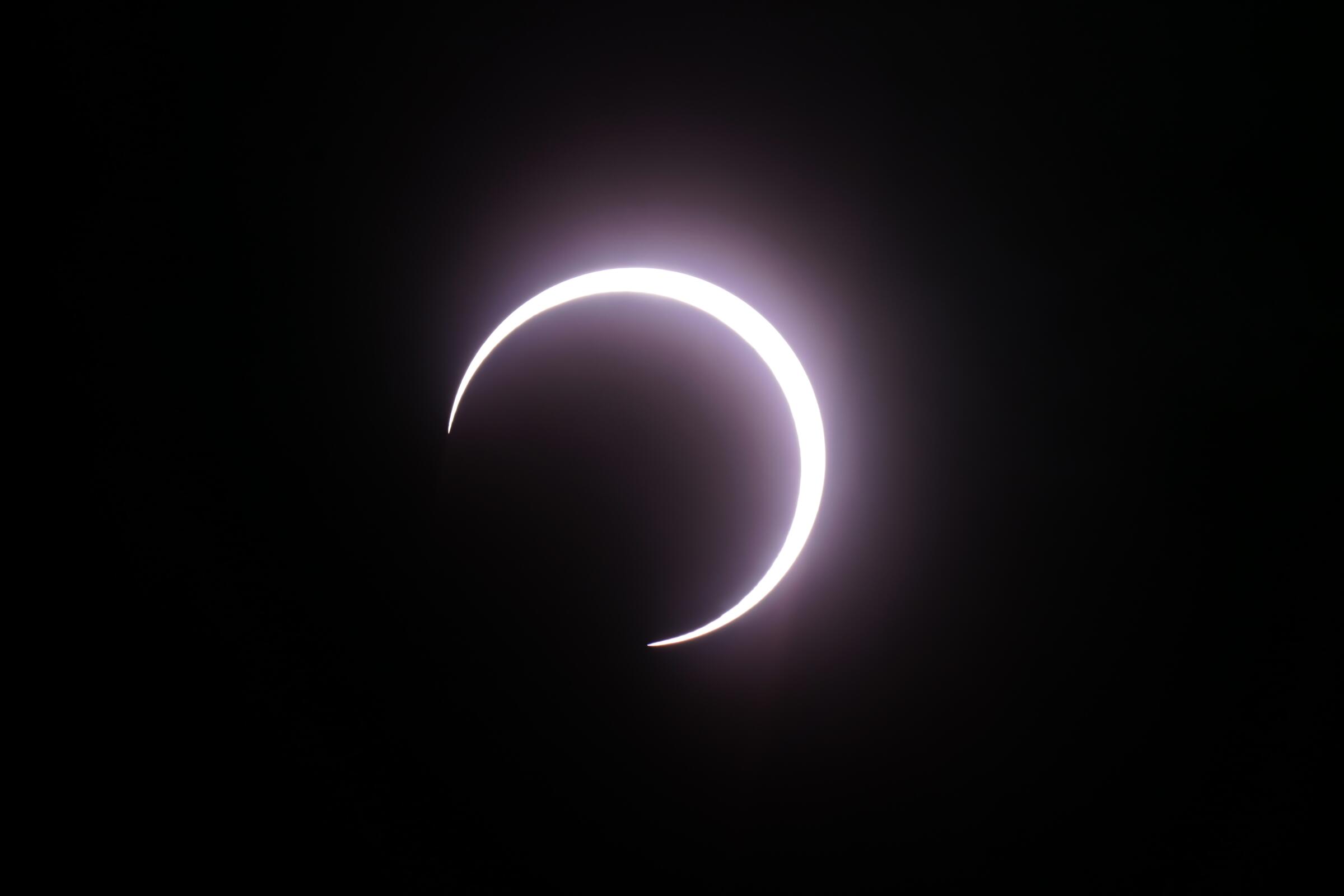
BLUFF, Utah — When Mayor Ann Leppanen learned that the moon would cross in front of the sun above her home on Saturday, she foresaw calamity: a tidal wave of tourists engulfing her tiny town as they pursued the annular eclipse, with its spectacular ring of fire.
The town’s economy has long relied on a modest, steady flow of visitors drawn to its red-rock canyons, coursing San Juan River, and wind-swept solitude. But in January, this hamlet of 250 people began appearing on lists of the best places to view the rare celestial event — the town has almost no light pollution and it was in the precise center of the eclipse’s path. Reservations for hotel rooms and campsites began to climb, and by early September every bed was booked for the weekend.
Leppanen predicted that day-trippers and people camping on public land just outside the city limits would give rise to a crowd far larger than the city had ever seen.

“If even 1,000 people show up, it will be a disaster,” Leppanen said last month, shaking her head in the small room in the senior center that also serves as the mayor’s office. “I think we’ll have 20,000 — and I don’t think I’m underestimating.”
Leppanen worried that Bluff would run out of everything, even gasoline, and that if anyone was injured, bumper-to-bumper traffic on the highway through town could block an ambulance from arriving in a timely manner.
Compounding her anxiety was a serious labor shortage. Like many towns in the Four Corners region, Bluff has a workforce that is almost entirely Diné, or Navajo. An eclipse is a solemn, sacred occasion for the Navajos: the death of the sun. The devout would remain inside to avoid the sight.
“Growing up, I’ve been told that we’re not supposed to eat or do anything else — that time is just to meditate,” said Nizhoni Spencer, a cook at the Twin Rocks diner. “If you don’t do that, it will affect you no matter what. Because for us Navajos, [the eclipse] is different for us — being Diné, it affects not only physically, but spiritually and emotionally as well.”
Given the sanctity of the event, most employers gave their Navajo employees the choice to remain home, or at least take a work break and remain indoors during the four plus hours of the eclipse.
As the first rays of the sun peeked above the mountains east of the desert, apprehensive locals wondered if they would survive the flood.
:::
Across the country, small, scenic towns like Bluff have had to contend with our growing desire to travel far out into what was once the middle of nowhere.
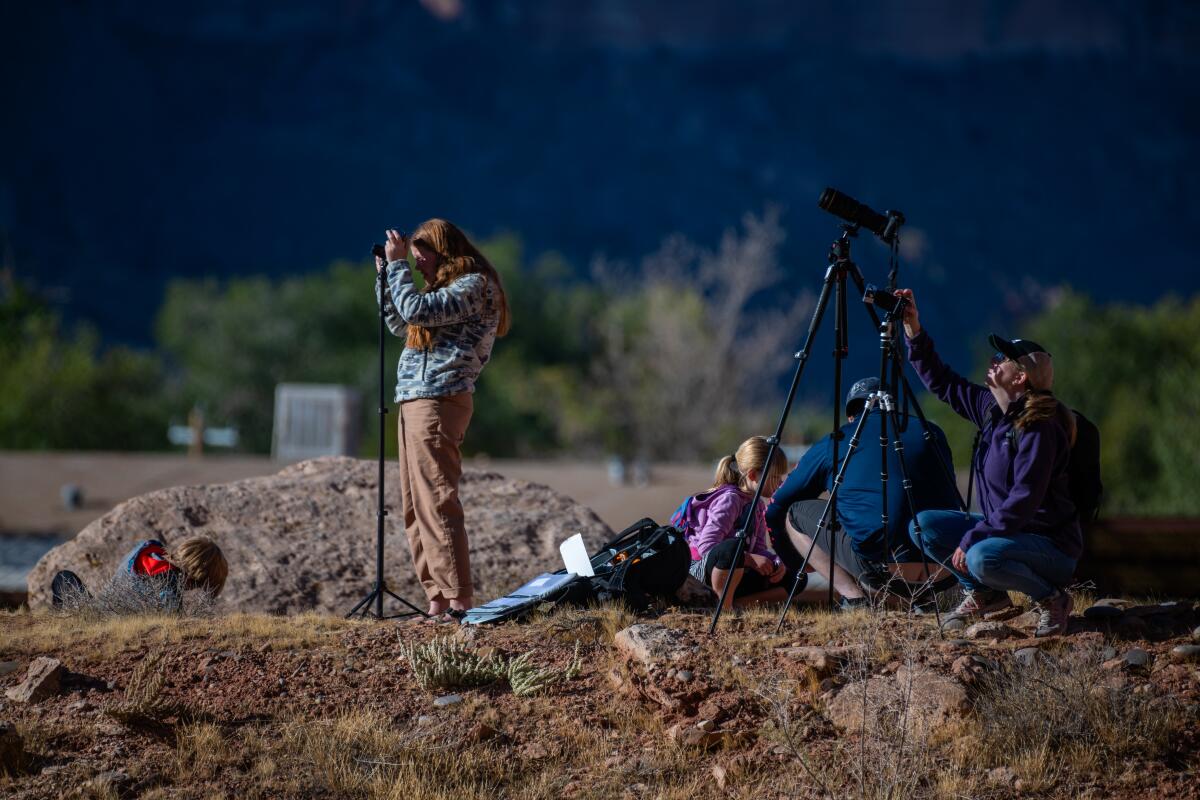
Instagram, with its viral shots of canyons and wide-open sky, has turned tens of thousands of people into road-trippers, venturing deep into rural corners of the United States, seeking the perfect shot. And during the pandemic, rural vistas offered a drivable vacation, with plenty of space to social-distance.
The surge in tourism in communities such as Bluff is associated with more than anxiety — it has created an existential crisis of sorts. In addition to practical matters such as zoning and water use, the increase in visitors has prompted questions about ownership and privilege, conservation and public resources. Put simply: Is it antisocial to ask that we keep our lonely places lonely?
Across Utah, tiny towns have had to confront city-sized problems as tourists fill the sidewalks. In Springdale, a gateway to Zion National Park, workers suddenly face long commutes, as the rising cost of housing forces them farther out of town and lines to enter the park back up traffic for hours.
Perhaps no western city better represents the conflict of solitude and tourism than Moab, an outdoors paradise just outside Arches National Park. That conflict is acknowledged in Bluff with a bumper sticker that’s hard to miss around town (including on the mayor’s thermos): “Don’t Moab My Bluff.”
Leppanen says that when she first visited Moab 30 years ago, it was just a “corner of development” with a couple of motels. Fast-forward to 2023, and Moab sees more than 3 million visitors each year. The tourism surge has led to a housing crisis, a water shortage and a traffic mess. Last year, 59% of Moabites polled by the Utah Office of Tourism said they felt that quality of life had declined because of tourism, and 67% thought that it’d had negative effects on the natural environment.
“For me, ‘Don’t Moab My Bluff’ comes down to planning — how do we promote development and tourism without draining our town of resources, or losing our housing supply for residents, if all the homes turn into short-term rentals?” Leppanen said.
A few days before the eclipse, she was interviewed by a reporter for the Salt Lake Tribune, with whom she shared her fears that Bluff would run out of food and gas. The story ran with a stark headline: “Mayor of small town in Utah to eclipse viewers: ‘Don’t try to come here.’ ”
:::
As the moon started inching toward the sun around 8:30 a.m. Saturday, it looked like the town’s warning to tourists had been taken to heart. Although a few thousand eclipse viewers did make their way to the red-sand fields around the town, it was quickly apparent that Bluff had over-prepared. Most of the tourists had instead gone south into the Navajo Reservation, to the geological formations in the Valley of the Gods and Mexican Hat. Before dawn Saturday, southbound traffic to both locations was already backed up for miles.
In Bluff, the sun rose on an anticlimax.
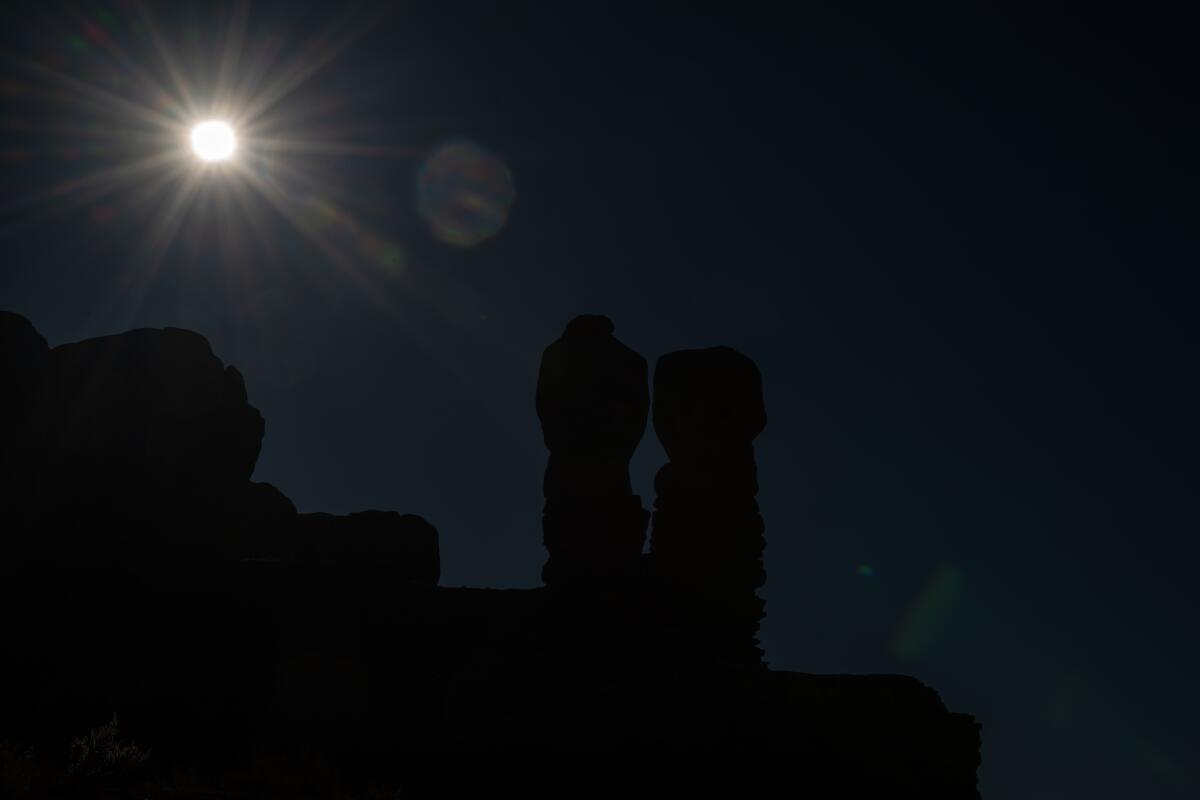
Alicia and Bryan Rollo were among the tourists who did arrive; they drove down from Providence, Utah, with their four children. As the temperature dropped and the land got darker, they stood next to an array of cameras on tripods, waiting to get the right shot.
They both said they were nervous about potential crowds. The family had gone to see a total eclipse in Idaho in 2017 and had spent hours in bumper-to-bumper traffic. “We heard the mayor saying, ‘Don’t come to Bluff, don’t come to Bluff. They’ll be too many people,” Bryan said.
“And we heard that, weeks ago, the road signs in southern Utah were warning about the traffic,” Alicia added.
Bryan said he agreed with the importance of not overcrowding small towns. “It’s a balance,” he said. The family had planned to avoid Bluff and head farther south, but when they passed through the town and the crowds seemed small, they decided to stop.
A few hundred feet away, Spencer stood quietly in the kitchen of Twin Rocks diner. Monica Hatahlie, another Diné worker whom Spencer considers to be a sister, huddled next to her. They tensed up whenever someone opened the doors to the kitchen, and they both stayed in its far-back corner, anxious to avoid the windows.
1
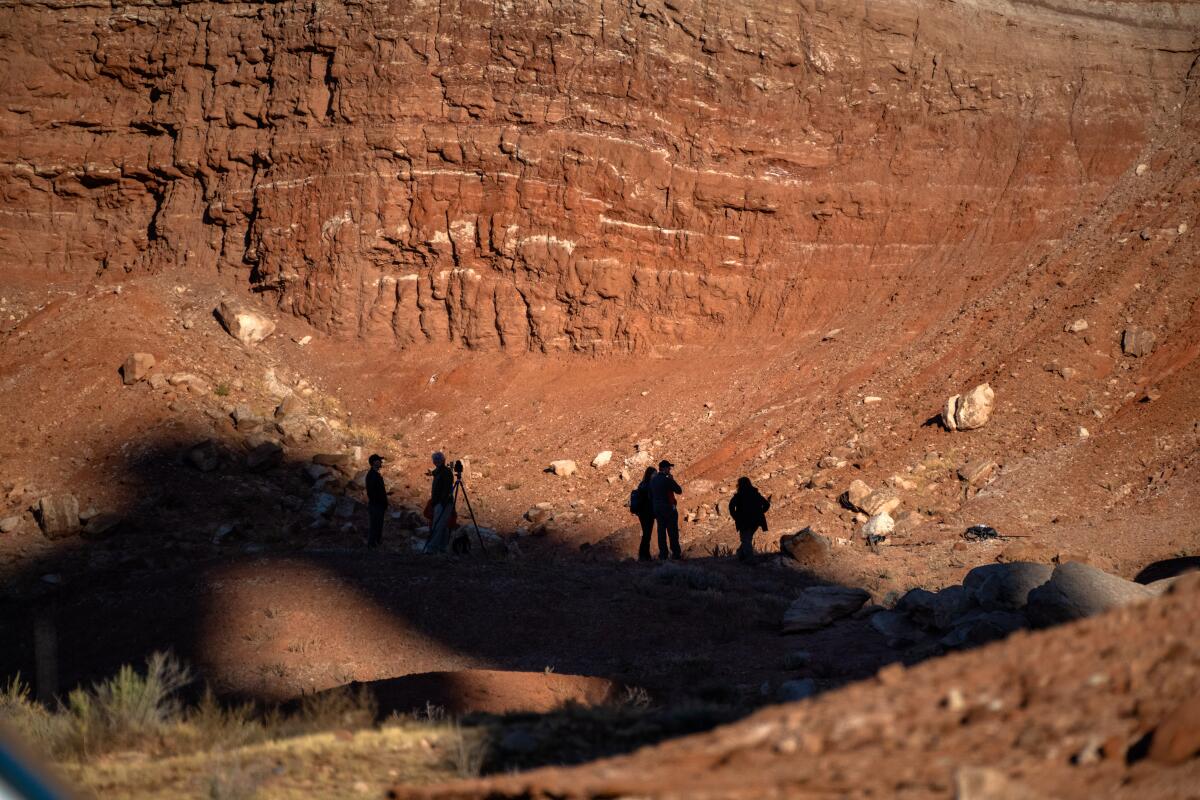
2

3
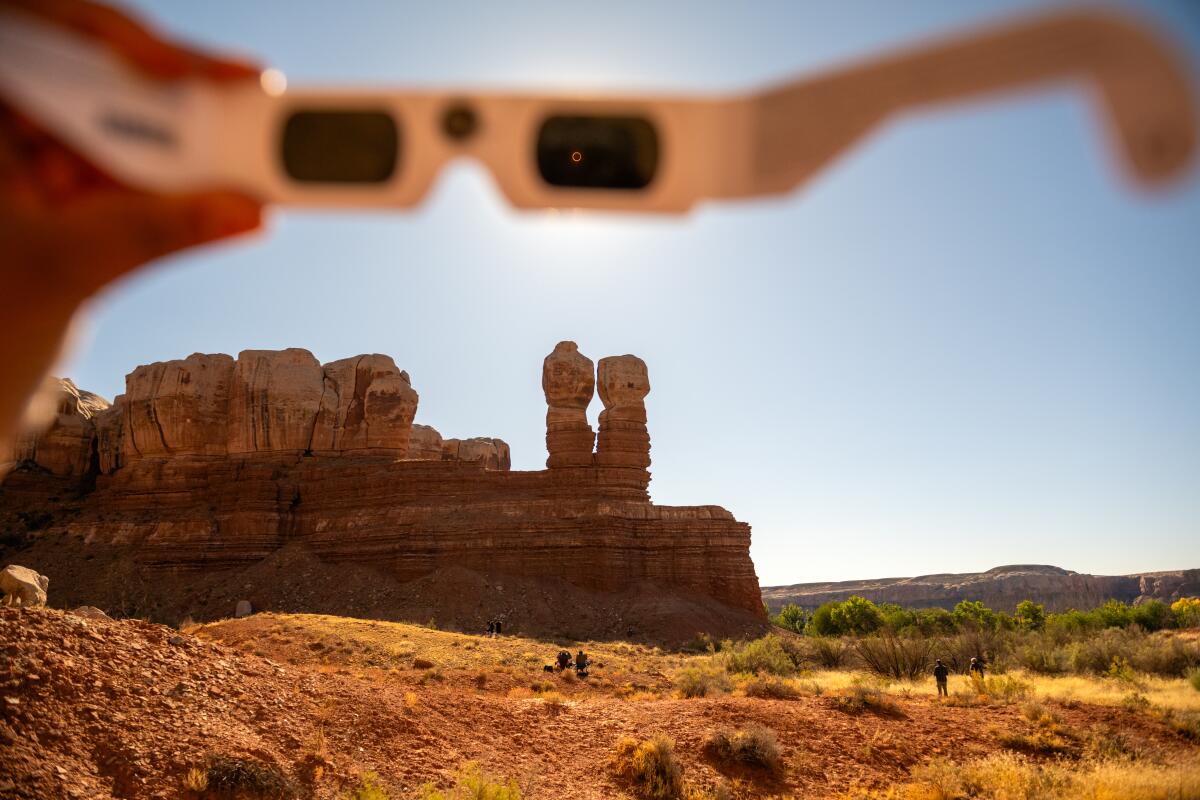
1. Tens of thousands were expected to visit for the eclipse in Bluff, Utah, US, on Saturday, Oct. 14, 2023. But, perhaps do to messaging from the mayor and others, many folks stayed away and much of the preparations businesses made for the anticipated tourists were wasted. (Ash Ponders/Photographer: Ash Ponders/LA Times) 2. Tens of thousands were expected to visit for the eclipse in Bluff, Utah, US, on Saturday, Oct. 14, 2023. But, perhaps do to messaging from the mayor and others, many folks stayed away and much of the preparations businesses made for the anticipated tourists were wasted. (Ash Ponders/Photographer: Ash Ponders/LA Times) 3. A view of the eclipse through special glasses. (Ash Ponders/Photographer: Ash Ponders/LA Times)
“Right now, the sun is dying,” Spencer said. “It’s hard because we’re supposed to be at home with our families.”
Spencer said that she avoids even seeing photos of the eclipse online. For months before the ring of fire, traditional Navajos had to dodge posters advertising its arrival. Some Navajo workers at hotels, when asked by tourists where to go to see the eclipse, had to patiently explain that they avoid it.
“It’s really ironic, because there are thousands of people here now, and they’re coming to the very exact place where we have a tribe here with this cultural belief,” Spencer said. She laughed when asked whether she thought an eclipse in Dinétah, the Navajo homeland, should be a government-designated holiday, such as Easter and Christmas. “We’re just so used to being treated that way, for not being acknowledged, that it doesn’t faze us.”
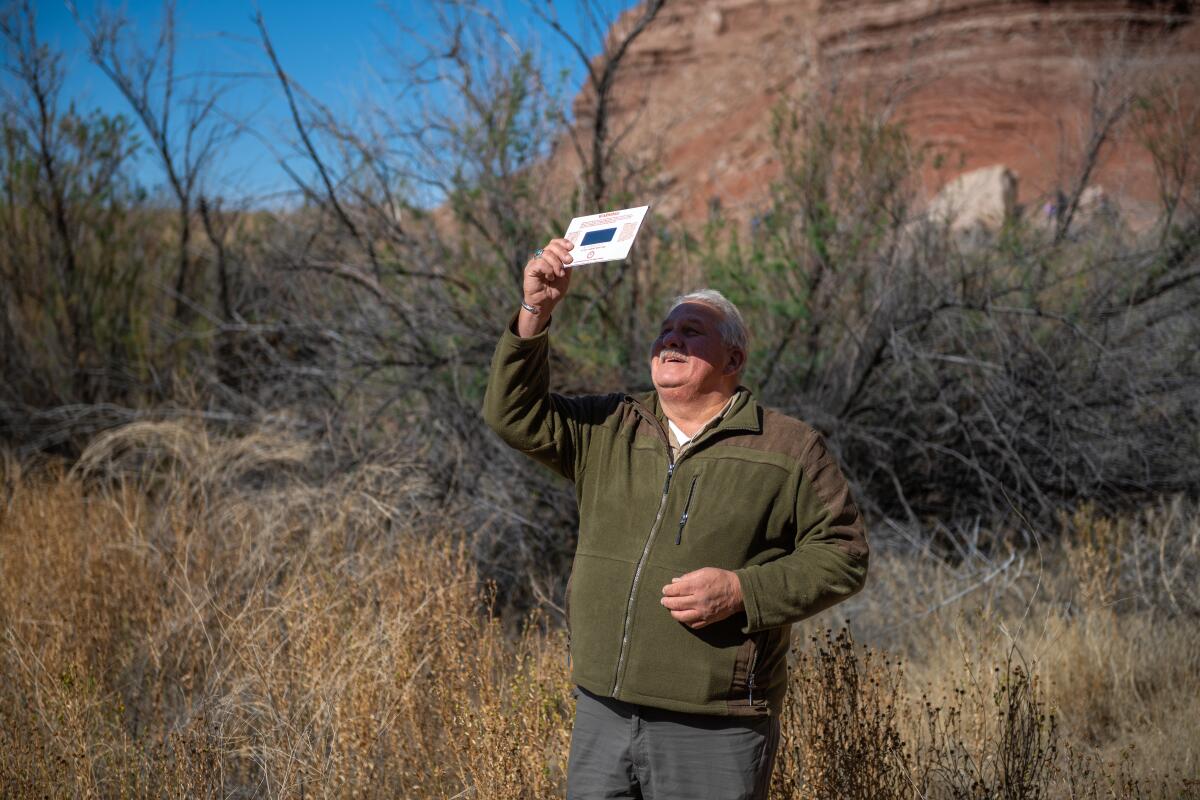
At the same time, many of the tourists outside the diner — including the Rollo family — said they’d learned about Navajos’ relationship with the eclipse during their research and were glad to hear Navajo employees didn’t have to work while it was taking place.
:::
About a mile away, at the Bluff Dwellings hotel, owners Spring and Jared Berrett fired up their barbecue. They’d given the hotel’s Navajo restaurant workers the morning off during the eclipse, and they were running the lunch service.
As the moon and the sun began to part, Jared Berrett said that although he supported the town making sure that only a sustainable number of visitors showed up for the eclipse, he felt that there had been an “overcorrection” — now, not enough people had shown up.
“There’s often a bit of tension in small towns between wanting to be able to pay your bills as a business owner, and residents wanting to not have too much influx of inconvenience — you know, people, traffic. I think that played out here,” he said.
Berrett said it’s not hard to understand what his fellow residents are trying to preserve. When asked about what made him decide to move to Bluff 15 years ago, he had a one-word answer: “Solitude.” As their hotel has expanded — the Berretts added a three-story building last year — he says residents worry his business is threatening that solitude. At town meetings, neighbors have voiced their concerns about noise, water use and other effects.
“That’s the Catch-22,” Berrett said. “We still want to find solitude and have our guests find solitude. But, frankly, I think there’s a bit of over-caution among the townspeople in general. We’re so remote that we’re never going to see a huge population — we’re never going to be a Sedona [Arizona], we’re not going to be a Moab.”
Berrett mentioned that the owners of a nearby Canyon Smokehouse had rented an entire refrigerated semi-truck to store brisket and other cuts of meat, in anticipation of huge crowds. Now, without the expected rush, he worried that they might be feeling “a little frantic” — they had made a huge investment, and could risk losing it if tourists didn’t show up.
Interviewed later in the day, the smokehouse’s owner, Erin Nelson, said she’d felt plenty nervous when the restaurant opened to tiny crowds. But by lunchtime, a steady crowd filled most of the tables — many of the customers were road-tripping back north and stopped in town to eat.
“That’s the hardest question we’re answering today,” Nelson said, when asked whether she felt the town’s messaging might have scared off customers. But she also serves as the town manager, and she sympathized with Leppanen’s decision to discourage eclipse tourism.
“I think from her position specifically, she made the right call in her role — her job is to keep residents safe,” Nelson said. “Small towns often walk this line between an economic policy and safety for their residents.”
:::
On Monday, after most of the tourists had packed up, Leppanen said she had no regrets. “I would have rather over-prepared than under-prepared,” she said.
And although she felt the Salt Lake Tribune had taken her “Do not come” message out of context, she said that, as mayor, it was important to balance the good of tourism with the bane of overcrowding.
“That’s the question,” she said. “How do you avoid becoming one of those places that people just love to death?”
Start your day right
Sign up for Essential California for news, features and recommendations from the L.A. Times and beyond in your inbox six days a week.
You may occasionally receive promotional content from the Los Angeles Times.